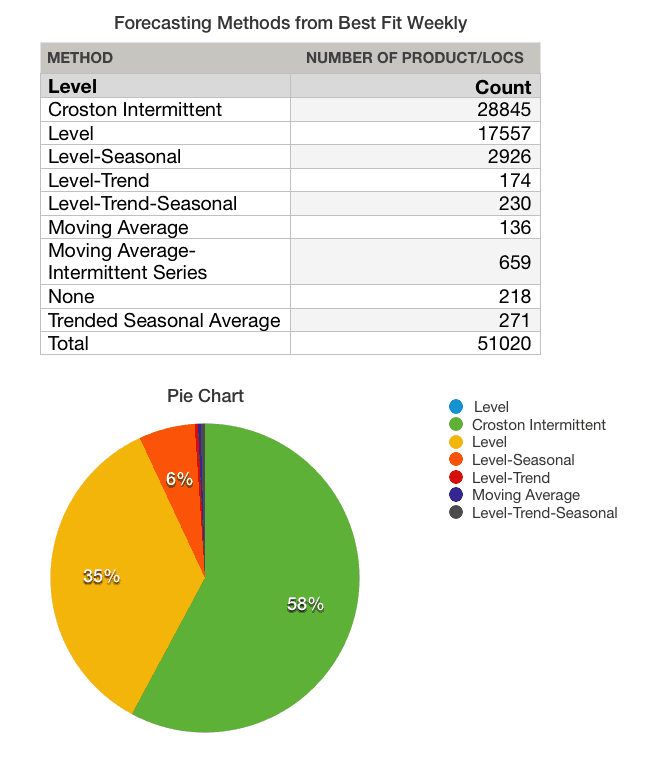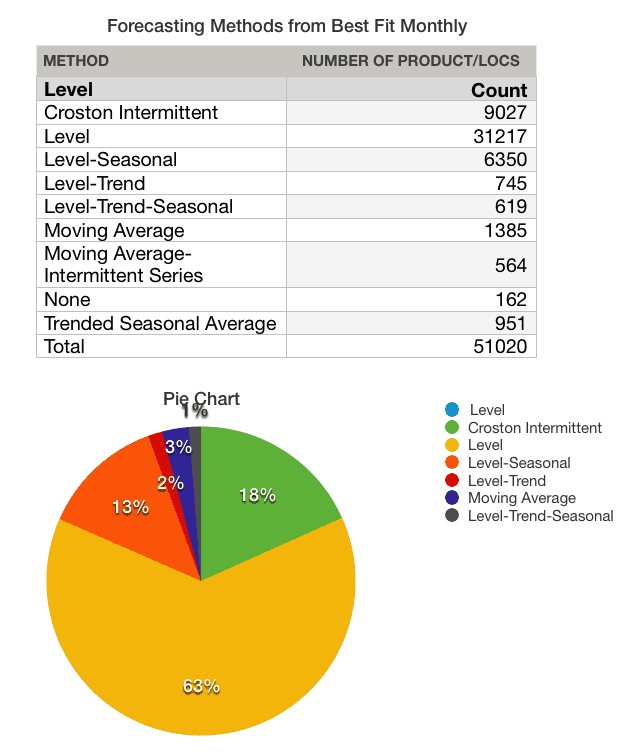The Brightwork Forecast Model Assignment and Profiling Project
Executive Summary
- Companies often have statistical forecast models assigned to product locations, but without knowing if the model assignment is up to date.
- Model assignment also allows for the overall product database to be profiled.

Introduction
The statistical forecast model assignment is which statistical forecasting models apply to which product locations combinations. This does not mean that a statistical model is the best forecast that should be applied, but it is a first test or a baseline that companies should know about their product database. The following is what we provide during a product assignment project.
See our references for this article and related articles at this link.
Forecast Model Assignment
The following is a model assignment to product location (aggregated) graphic for one company that has been made anonymous.
![]()

This is when the forecast bucket is weekly. The statistical forecast models that are assigned will change depending upon the forecast bucket.
Now let us look at the same dataset when performing monthly forecasted.
The Monthly Best Fit

Comparing to the Company’s Model Assignment
The second step is extracting the forecast model assignment that is currently in the forecasting system. And then finding the variance between the external assignment and the internal assignment.
What Does Assignment Show?
Purely statistical assignment only serves to illustrate the fit between the previous forecast (fitted forecast) and the demand history.
There are many reasons to apply a different forecast than the assigned model, which is why we do not recommend using a model assignment algorithm “blindly” in production.
- This part of the analysis typically requires business knowledge to explain why the statistically selected forecast model is not the one that is to be applied.
- In all cases where we have performed this analysis we have found out of date assignments. Most of our analysis has been of companies that use the SAP DP forecasting system.
- This issue may be more pronounced in SAP DP than in other forecasting systems because DP is a highly encapsulated system, which makes model reassignment complicated, mainly to make the adjustment in a way that persists to the (typically) weekly forecasting batch job.
Degradation of the SAP DP System
SAP consulting companies do not tell their clients that SAP DP has a high likelihood of becoming either unsupportable or diverging from the fit with the product location demand history after implementation. And more than this, we have observed a number of SAP DP projects where either in haste to complete the project, budget constraints, or poor quality consultants, nothing more than a technical implementation is performed. That is, the system is brought up to the minimum standards of “working” before the consultants leave the project.
All of this means that the credibility of the system tends to be reduced with demand planners (and often other stakeholders) and that it becomes commonplace to apply far more manual overrides than would ordinarily be the case.
Conclusion
Brightwork has a long history of forecast testing. And one aspect of testing is a comparison of the currently assigned statistical models to a fresh analysis of every product location combination. Here are the things necessary to perform the analysis.
- The demand history for all forecasted product location combinations.
- The extract of the current forecast model to product location assignments (normally extracted from the forecast system).
There is another issue, which is that we recommend forecast assignments be kept external to the forecasting system, and updated. The reason is so that everyone can very easily see the assignment. If companies have a corporate version of G Suite, then Google Sheets is an excellent example of this, as it can be updated and viewed by multiple people at the same time, and areas can also be locked.
The Cost
We can typically perform this analysis for around $4,000. This includes both the math portion of the analysis, as well as documentation that explains the analysis. We also including supporting articles in specific parts of the documentation that points back explanatory articles on the Brightwork website.